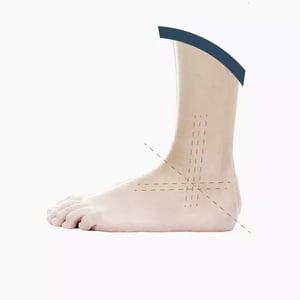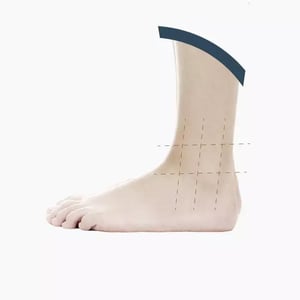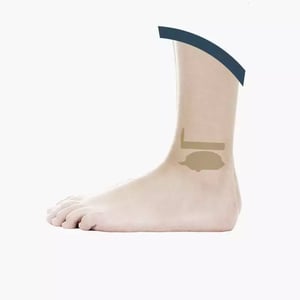Ankle Resurfacing Prosthesis
The Prosthetic Design
Each prosthetic design must balance two opposing concepts:
- Articular congruency, which aims to replicate the original anatomy as closely as possible.
- Constraint, which refers to the limitation of movement of the components, and needs to be carefully managed to prevent instability and wear.
Historically, the first reliable solution to integrate these two concepts was the development of mobile-bearing prostheses. These implants consist of a tibial component, a talus component, and a polyethylene mobile piece placed between the two.
This approach has allowed mechanical stress to be dissipated across two interfaces: the mobile polyethylene and the talus component, effectively distributing the forces the prosthesis must endure.
The reduction in stress has led to fewer components being required in prosthetic designs. With mobile-bearing prostheses, the bulky and cumbersome nature of first and second-generation implants has been minimized.
For patients, the most immediate benefit is the longer lifespan of the implant.
However, the downside is the reduction in joint range. In fact, mobile-bearing prostheses rarely provide the "broad" range of motion seen in a healthy, physiological ankle.
What we've learned from mobile-bearing prostheses is the importance of keeping implants as compact as possible to preserve bone stock in both the tibia and talus.
Mobile-bearing technology remains relevant today. In fact, modern designs have evolved from its innovations, offering greater functionality and reduced invasiveness for the patient.
The main goal today is to more closely replicate the original anatomy of the ankle. Modern prostheses aim to combine bone-stock preservation with improved functionality.
Ankle Resurfacing Prosthesis

The evolution and success of the fixed-bearing resurfacing design can be explained by its approach to creating a prosthetic system with a single, stable interface between the tibia and talus. Unlike mobile-bearing prostheses, there is no movable component between the two, yet this design still achieves improved joint movement while significantly preserving bone stock.
Resurfacing prostheses replicate the original ankle anatomy by adhering to two simple but crucial principles.
Firstly, the articular surfaces of both the tibia and talus are curved.
With resurfacing, bone resection can be minimized by making curved cuts that follow the natural curvature of the tibia and talus. This technique allows for more precise bone preservation, as it respects the original anatomical contours.
To make these curved cuts, a lateral approach is required. This marks the first innovation of the resurfacing design: curved cuts are made to replicate the original anatomy of the ankle, performed from the side through an osteotomy of the fibula, which provides better exposure of the joint. This approach also offers a direct view of the center of rotation for the new articulation.
In resurfacing, the goal is to create a prosthesis composed of two main components: the tibial and talar articular surfaces. This design eliminates the need for the mobile component found in mobile-bearing prostheses, focusing solely on the natural, stable interface between the two bones.
For this to be possible, the use of innovative, technologically advanced materials is essential. This is the second major innovation of resurfacing: the use of Trabecular Metal™.

Trabecular Metal™ is a material derived from the processing of Tantalum, designed to closely replicate the porosity and biomechanical properties of bone tissue.
This material enables bone reconstruction that is so reliable that it is recognized and integrated by the body as real bone tissue. This unique characteristic ensures exceptional osseointegration, providing both outstanding stability and reduced healing time.
It is the combination of Trabecular Metal™ and the curved cuts that allow resurfacing to provide us with a prosthetic implant that offers intrinsic stability well above average.
These two characteristics make it possible to forgo the third mobile element (the polyethylene part). As a result, we are talking about a fix-bearing arthroplasty (with two components), which not only allows for greater movement of the neo-articulation but also generally leads to faster recovery times.
I quickly embraced and further developed these concepts in my practice, and today my team has the largest case study in Europe for this specific prosthetic design.
It is a choice that is both revolutionary and reliable, offering great advantages.
You might also be interested in: Ankle Prosthesis: 12 Key Information Points for the PatientA prosthesis that approaches the form and function of a healthy ankle.
A Prosthesis that Mimics a Healthy Ankle in Form and Function: Our Scientific Research

The significant difference between the ankle and other large joints of the lower limb (such as the hip and knee) is that the ankle rarely undergoes the same aging process.
Even in very elderly patients, the ankles are often healthy.
Pain and arthritis in the ankle typically result from trauma (such as fractures) or deformity.
As a result, it's not uncommon for patients to have one arthritic ankle while the other remains perfectly healthy.
This is much less common in the knee or hip, where arthritis usually affects both joints as the patient ages.
This characteristic has allowed us to compare two different prosthetic designs with the healthy ankle (the contralateral, or non-operated, ankle).
It was a truly innovative study: “Tibial slope in total ankle arthroplasty: Anterior or lateral approach” which enabled us to observe that with the resurfacing prosthesis, the axes and joint angles were restored in a way very similar to that of a healthy ankle.
This indicates that the resurfacing prosthetic design is closer to the goal of replicating the original ankle in both form and function.
Of course, it's important to remind patients that an ankle prosthesis, even the resurfacing design, will never fully replicate the behavior of a healthy ankle in a twenty-year-old. However, the closer the prosthesis is to the healthy ankle's shape, the more closely it can replicate its performance.
My Team and Our Research: What We’ve Contributed
When this prosthetic design was created, it was naturally associated with a new surgical technique.
The potential limitations of this new design were longer surgeries compared to other prosthetic options. This was due to the high precision and accuracy required by the tools.
However, our extensive experience in treating patients with osteoarthritis, coupled with the prosthetic surgical expertise of our team, has allowed me to develop an original surgical technique. This technique combines the remarkable precision of the system with reduced surgery times, resulting in significant advantages for the post-operative recovery of patients.
Today, two publications in international journals discuss our technique, which is actively shared and taught to numerous Italian and European visitors who come to our operating theaters daily. Their goal is to learn or improve their skills in prosthetic surgery: “Treatment of Ankle Osteoarthritis with Total Ankle Replacement Through a Lateral Transfibular Approach” and “Total ankle replacement through a lateral approach: surgical tips”.
Innovation and reliability are the correct summary of this technique, which has allowed us to achieve exciting results in terms of functional recovery and long-term implant durability. My team has reported the best medium-term result ever published in the field of ankle prosthetics: 97.7% of patients show no signs of wear after 5 years, and 90% after 10 years (Transfibular total ankle arthroplasty: a new reliable procedure at five-year follow-up - Bone Joint J. 2022 Apr).
The key to prosthetic surgery is attention to every detail: patient preparation, anesthesia, post-operative pain management, and the precision and readiness of every action in the operating room, not only mine but also that of the entire team.
The key to prosthetic surgery is attention to every detail: patient preparation, anesthesia, post-operative pain management, and the precision and readiness of every action in the operating room, not only mine but also that of the entire team.


